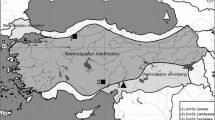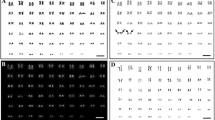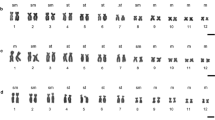Abstract
The distribution and quantity of constitutive heterochromatin and of the nucleolus organizer regions (NORs) on the chromosomes of 22 species of bufonids and hylids (Amphibia, Anura) was investigated. Three different kinds of constitutive heterochromatin were found and the frequency of brightly fluorescing heterochromatic regions was remarkably high. On almost all chromosomes there is centric and telomeric heterochromatin. Quantitative estimates of heterochromatin demonstrate that large DNA differences among closely related species can not be attributed to differing quantities of constitutive heterochromatin. In all species investigated, only one homologous pair of NORs was found, which lies preferentially in the proximal and interstitial segments of the long chromosome arms. The NORs are always associated with constitutive heterochromatin on both sides. The size variability between homologous NORs is very high. In the euchromatic regions of the metaphase chromosomes, neither Q- nor G-bands can be demonstrated; this can be attributed to an extremely strong contraction of the anuran chromosomes. On the basis of these results various mechanism of the chromosomal evolution in Anura are discussed.
Similar content being viewed by others
References
Arrighi, F.E., Hsu, T.C., Pathak, S., Sawada, H.: The sex chromosomes of the Chinese hamster: constitutive heterochromatin deficient in repetitive DNA sequences. Cytogenet. Cell Genet. 13, 268–274 (1974)
Bachmann, K.: Specific nuclear DNA amounts in toads of the genus Bufo. Chromosoma (Berl.) 29, 365–374 (1970)
Bachmann, K.: Genome size in mammals. Chromosoma (Berl.) 37, 85–93 (1972)
Bailly, S.: Localisation et signification des zones Q observeés sur les chromosomes mitotiques de l'amphibien Pleurodeles waltlii Michah. après coloration par la moutarde de quinacrine. Chromosoma (Berl.) 54, 61–68 (1976)
Baldari, C.T., Amaldi, F.: DNA reassociation kinetics in relation to genome size in four amphibian species. Chromosoma (Berl.) 59, 13–22 (1976)
Beçak, W., Beçak, M.L., Schreiber, G., Lavalle, D., Amorim, F.O.: Interspecific variability of DNA content in Amphibia. Experientia (Basel) 26, 204–206 (1970)
Bianchi, N.O., Bianchi, M.S., Vidal-Rioja, L.: Heterochromatin late replication and secondary constrictions in the chromosome complement of Leptodactylus ocellatus. Caryologia (Firenze) 26, 397–403 (1973)
Birnstiel, M.L., Sells, B.H., Purdom, I.F.: Kinetic complexity of RNA molecules. J. molec. Biol. 63, 21–39 (1972)
Blair, W.F.: Genetic compatibility and species groups in U.S. toads (Bufo). Texas J. Sci. 11, 427–453 (1959)
Blair, W.F.: Evolutionary relationships of North American toads of the genus Bufo: a progress report. Evolution (Lawrence, Kans.) 17, 1–16 (1963)
Blair, W.F.: Characteristics of the testes. In: Evolution in the genus Bufo (W.F. Blair, ed.), pp. 324–328. Austin-London: University of Texas Press 1972
Blair, W.F.: Evidence from hybridization. In: Evolution in the genus Bufo (W.F. Blair, ed.), pp. 196–232. Austin-London: University of Texas Press 1972
Bogart, J.P.: Chromosome number difference in the amphibian genus Bufo: the Bufo regularis species group. Evolution (Lawrence,Kans.) 22, 42–45 (1968)
Bogart, J.P.: Karyotypes. In: Evolution in the genus Bufo (W.F. Blair, ed.), pp. 171–195. Austin-London: University of Texas Press 1972
Brown, D.D., Weber, C.S.: Gene linkage by RNA-DNA hybridization. I. Unique DNA sequences homologous to 4S RNA, 5S RNA and ribosomal RNA. J. molec. Biol. 34, 661–680 (1968)
Brown, D.D., Wensink, P.C., Jordan, E.: Purification and some characteristics of 5S DNA from Xenopus laevis. Proc. nat. Acad. Sci. (Wash.) 3175–3179 (1971)
Cei, J.M., Erspamer, V., Roseghini, M.: Biogenic amines. In: Evolution in the genus Bufo (W.F. Blair, ed.), pp. 233–243. Austin-London: University of Texas Press 1972
Davidson, E.H., Amenson, C., Hough, B., Britten, R.J.: Interspersion of repetitive sequences in Xenopus DNA. Carnegie Inst. Wash. Year Book 71, 273–276 (1972)
Davidson, E.H., Hough, B.R., Amenson, C.S., Britten, R.J.: General interspersion of repetitive with non-repetitive sequence elements in the DNA of Xenopus. J. molec. Biol. 77, 1–25 (1973)
Dutrillaux, B., Grouchy, J. de, Finaz, C., Lejeune, J.: Mise en évidence de la structure fine des chromosomes humains par digestion enzymatique (pronase en particulier). C.R. Acad. Sci. (Paris) 273, 587–588 (1971)
Engel, W., Zenzes, M.T., Schmid, M.: Activation of mouse ribosomal RNA genes at the 2-cell stage. Hum. Genet. 38, 57–63 (1977)
Garcia Ruiz, I.R., Beçak, W.: Further studies on polyploid amphibians. V. C-banding in diploid and tetraploid species of Odontophrynus. Chromosoma (Berl.) 54, 69–74 (1976)
Goin, O.B., Goin, C.J., Bachmann, K.: DNA and amphibian life history. Copeia (Wash.) 532–540 (1968)
Goodpasture, C., Bloom, S.E.: Visualization of nucleolar organizer regions in mammalian chromosomes using silver staining. Chromosoma (Berl.) 53, 37–50 (1975)
Greilhuber, J.: Why plant chromosomes do not show G-bands. Theor. Appl. Genet. 50, 121–124
Griffiths, I.: The phylogeny of the Salientia. Biol. Rev. 38, 241–292 (1963)
Guttman, S.I.: Evolution of blood proteins in the cosmopolitan toad genus Bufo. Ph. D. Thesis, Univ. Texas (1967)
Hsu, T.C.: Heterochromatin pattern in metaphase chromosomes of Drosophila melanogaster. J. Hered. 62, 285–287 (1971)
Hsu, T.C., Arrighi, F.E.: Distribution of constitutive heterochromatin in mammalian chromosomes. Chromosoma (Berl.) 34, 243–253 (1971)
Hsu, T.C., Cooper, J.E.K., Mace, M.L., Brinkley, B.R.: Arrangement of centromeres in mouse cells. Chromosoma (Berl.) 34, 73–87 (1971)
Hsu, T.C., Pathak, S., Chen, T.R.: The possibility of latent centromeres and a proposed nomenclature system for total chromosome and whole arm translocations. Cytogenet. Cell Genet. 15, 41–49 (1975)
Hsu, T.C., Spirito, S.E., Pardue, M.L.: Distribution of 18+28S ribosomal genes in mammalian genomes. Chromosoma (Berl.) 53, 25–36 (1975)
Inger, R.F.: Bufo of Eurasia. In: Evolution in the genus Bufo (W.F. Blair, ed.), pp. 102–118. Austin-London: University of Texas Press 1972
Jalal, S.M., Clark, R.W., Hsu, T.C., Pathak, S.: Cytological differentiation of constitutive heterochromatin. Chromosoma (Berl.) 48, 391–403 (1974)
Kongsuwan, K., Smyth, D.R.: Q-bands in Lilium and their relationship to C-banded heterochromatin. Chromosoma (Berl.) 60, 169–178 (1977)
Lee, C.S., Collins, L.: Q- and C-bands in the metaphase chromosomes of Drosophila nasutoides. Chromosoma (Berl.) 61, 57–60 (1977)
Lima-de-Faria, A.: Chromosome gradient and chromosome field in Agapanthus. Chromosoma (Berl.) 6, 330–370 (1954)
Lima-de-Faria, A.: The specific location of ribosomal genes in the eukaryotic chromosome. In: Modern aspects of cytogenetics: constitutive heterochromatin in man (R.A. Pfeiffer, ed.). Symp. Med. Hoechst 6, pp. 39–44. Stuttgart-New York: Schattauer 1973
Lima-de-Faria, A.: The chromosome field. I. Prediction of the location of ribosomal cistrons. Hereditas (Lund) 83, 1–22 (1976)
Low, B.S.: Evolution in the genus Bufo: evidence from parathoid glands. Ph. D. Thesis, Univ. Texas (1967)
Lubs, H., Hosteller, T., Ewing, L.: Cited in Paris Conference (1971): Standardization in human cytogenetics. Birth defects: original article series, vol. 8, No. 7. New York: The National Foundation 1972
Martin, R.F.: Evidence from osteology. In: Evolution in the genus Bufo (W.F. Blair, ed.), pp. 37–70. Austin-London: University of Texas Press 1972
Martin, W.F.: Evolution of vocalization in the genus Bufo. In: Evolution in the genus Bufo (W.F. Blair, ed.), pp. 279–309. Austin-London: University of Texas Press 1972
Matsui, S.: Structural proteins associated with ribosomal cistrons in Xenopus laevis chromosomes. Exp. Cell Res. 88, 88–94 (1974)
Miller, D.A., Dev, V.G., Tantravahi, R., Miller, O.J.: Suppression of human nucleolus organizer activity in mouse-human somatic hybrid cells. Exp. Cell Res. 101, 235–243 (1976)
Miller, O.J., Miller, D.A., Dev., V.G., Tantravahi, R., Croce, C.M.: Expression of human and suppression of mouse nucleolus organizer activity in mouse-human somatic cell hybrids. Proc. nat. Acad. Sci. (Wash.) 73, 4531–4535 (1976)
Morescalchi, A.: Comparative karyology of the Amphibia. Boll. Zool. 38, 317–320 (1971)
Morescalchi, A.: Amphibia. In: Cytotaxonomy and vertebrate evolution (A.B. Chiarelli and E. Capanna, eds.), pp. 233–348. London-New York: Academic Press 1973
Olmo, E.: Quantitative variations in the nuclear DNA and phylogenesis of the Amphibia. Caryologia (Firenze) 26, 43–68 (1973)
Overton, K.M., Magenis, R.E., Brady, T., Chamberlin, J., Parks, M.: Cytogenetic darkroom magic: now you see them, now you don't. Amer. J. Hum. Genet. 28, 417–419 (1976)
Pardue, M.L., Birnstiel, M.L.: Cytological localization of repeated gene sequences. In: Modern aspects of cytogenetics: constitutive heterochromatin in man (R.A. Pfeiffer, ed.), pp. 75–85. Stuttgart-New York: Schattauer 1973
Pardue, M.L., Brown, D.D., Birnstiel, M.L.: Location of the genes for 5S ribosomal RNA in Xenopus laevis. Chromosoma (Berl.) 42, 191–203 (1973)
Ragghianti, M., Bucci Innocenti, S., Mancino, G.: Bandeggiatura indotta da “C-, G- e Q-staining methods” e pattern di replicazione dei cromosomi di Triturus. Rend. Accad. naz. Lincei55, 764–770 (1973)
Schmid, W.: Heterochromatin in mammals. Arch. Klaus-Stift. Vererb.-Forsch. 42, 1–60 (1967)
Schmid, M., Krone, W.: The relationship of a specific chromosomal region to the development of the acrosome. Chromosoma (Berl.) 56, 327–347 (1976)
Schweizer, D.: Reverse fluorescent chromosome banding with chromomycin and DAPI. Chromosoma (Berl.) 58, 307–324 (1976)
Seabright, M.: The use of proteolytic enzymes for the mapping of structural rearrangements in the chromosomes of man. Chromosoma (Berl.) 36, 204–210 (1972)
Sexsmith, E.: DNA values and karyotypes of Amphibia. Ph. D. Thesis, Dept. of Botany, University of Toronto 1968
Stock, A.D., Mengden, G.A.: Chromosome banding pattern conservatism in birds and nonhomology of chromosome banding patterns between birds, turtles, snakes and amphibians. Chromosoma (Berl.) 50, 69–77 (1975)
Straus, N.A.: Comparative DNA renaturation kinetics in amphibians. Proc. nat. Acad. Sci. (Wash.) 68, 799–802 (1971)
Sumner, A.T.: A simple technique for demonstrating centromeric heterochromatin. Exp. Cell Res. 75, 304–306 (1972)
Tymowska, J.: Karyotype analysis of Xenopus tropicalis Gray, Pipidae. Cytogenet. Cell Genet. 12, 297–304 (1973)
Tymowska, J.: A comparative study of the karyotypes of eight Xenopus species and subspecies possessing a 36-chromosome complement. Cytogenet. Cell Genet. 18, 165–181 (1977)
Tymowska, J., Fischberg, M.: Chromosome complements of the genus Xenopus. Chromosoma (Berl.) 44, 335–342 (1973)
Tymowska, J., Kobel, H.R.: Karyotype analysis of Xenopus muelleri (Peters) and Xenopus laevis (Daudin), Pipidae. Cytogenet. Cell Genet. 11, 270–278 (1972)
Ullerich, F.-H.: Unterschiede im DNS-Gehalt der Genome von Bufo bufo und Bufo viridis. Z. Naturforsch. 20b, 720–722 (1965)
Ullerich, F.-H.: Karyotyp und DNS-Gehalt von Bufo bufo, B. viridis, B. bufo x B. viridis und B. calamita (Amphibia, Anura). Chromosoma (Berl.) 18, 316–342 (1966)
Ullerich, F.-H.: Weitere Untersuchungen über Chromosomenverhältnisse und DNS-Gehalt bei Anuren (Amphibia). Chromosoma (Berl.) 21, 345–368 (1967)
Vosa, C.G.: Heterochromatic banding patterns in Allium. II. Heterochromatin variation in species of the paniculatum group. Chromosoma (Berl.) 57, 119–133 (1976)
Weisblum, B.: Fluorescent probes of chromosomal DNA structure: three classes of acridines. Cold. Spr. Harb. Symp. quant. Biol. 38, 441–449 (1973)
Weisblum, B., Haseth, de, P.L.: Quinacrine, a chromosome stain specific for deoxyadenylatedeoxythymidylate-rich regions in DNA. Proc. nat. Acad. Sci. (Wash.) 69, 629–632 (1972)
Wolf, K., Quimby, M.C.: Amphibian cell culture: permanent cell line from the bullfrog (Rana catesbeiana). Science 114, 1578–1580 (1964)
Author information
Authors and Affiliations
Rights and permissions
About this article
Cite this article
Schmid, M. Chromosome banding in Amphibia. Chromosoma 66, 361–388 (1978). https://doi.org/10.1007/BF00328536
Received:
Accepted:
Issue Date:
DOI: https://doi.org/10.1007/BF00328536




